Grain Size Distribution and Provenance of Holocene Sand from the Sava River (Zagreb, Croatia)
Abstract
:1. Introduction
2. Materials and Methods
2.1. Geological Setting
2.2. Field Work and Sampling
2.3. Grain Size Distribution Determined by Dry Sieving
2.4. Grain Size Distribution Determined by Laser Granulometry
2.5. Heavy Liquid Separation
2.6. Magnetic Susceptibility Separation
2.7. Mineralogic–Petrographic Composition
2.8. X-ray Powder Diffraction Analysis (XRD)
3. Results
3.1. Sample 9453—Zaprešić Bridge
3.2. Sample 9451—The Podsused Bridge
3.3. Sample 9452—The Jankomir Bridge
3.4. Sample 9454—The Homeland Bridge
3.5. Sample 9455—Ikea
3.6. Sample 9493—Sisak
4. Discussion
4.1. Significance of Grain Size and Provenance Research
4.2. Grain Size Distribution and Provenance of Sand Grains in the Study Area
4.3. Shortcomings and Prospects of This Study
5. Conclusions
- -
- Upstream, in the western part of the City of Zagreb, predominately carbonate sand of distant (Alpine) and local (Medvednica Mt. and Samobor Hills) provenance prevail. Downstream, in the middle and eastern part of the City of Zagreb area, more siliciclastic sand is deposited in the Sava riverbed, originating mainly from the Medvednica Mt.;
- -
- More prevailing siliciclastic sand further downstream of the Sava River, near the city of Sisak, can be considered as a contribution from the Kupa River tributary;
- -
- Moreover, grain size distribution of the Sava River sands near the city of Zagreb show predominately medium and fine sand deposition, with prevailing medium sand downstream, due to a more artificially channelized riverbed;
- -
- Further 50 km downstream, near the city of Sisak and entering the Lonjsko Polje Nature Park, fine sand deposition significantly prevails, influenced by the lower hydrodynamic conditions and possible fine sand contribution of the Kupa River tributary;
- -
- Although various studies of the Zagreb alluvial aquifer system have been conducted so far, this study represent a novelty in its investigation into the grain size distribution of the riverbed sand itself, setting the foundations for investigations in the future;
- -
- Possible shortcomings of this study include the sampling strategy and the provenance aspects, which can be improved in future studies by broadening the scope of the study to near tributaries, as well as on the streams entering the Sava River. Since these streams mainly flow from the Medvednica Mt. through the urban city area, anthropogenic influence should be also considered.
Supplementary Materials
Author Contributions
Funding
Data Availability Statement
Acknowledgments
Conflicts of Interest
References
- Collinson, J.D. Alluvial Sediments. In Sedimentary Environments and Facies, 2nd ed.; Reading, H.G., Ed.; Blackwell Scientific Publications: Oxford, UK, 1986; pp. 20–62. [Google Scholar]
- Stow, D.A.V. Sedimentary Rocks in the Field—A Colour Guide; Manson Publishing: London, UK, 2005; 320p. [Google Scholar]
- Reading, H.G. Sedimentary Environments and Facies, 2nd ed.; Blackwell Scientific Publications: Oxford, UK, 1986; 615p. [Google Scholar]
- Miall, A.D. The Geology of Fluvial Deposits: Sedimentary Petroleum Geology; Springer: Berlin/Heidelberg, Germany, 1996; 582p. [Google Scholar]
- Boggs, S., Jr. Principles of Sedimentology and Stratigraphy; Prentice Hall: New York, NY, USA, 2011; 600p. [Google Scholar]
- Etobro, I.A.A.; Ejeh, O.I.; Ovwamuedo, G.O. Fluvial sedimentology of the river Ethiope sediments, Niger Delta, Southern Nigeria. Rud.-Geološko-Naft. Zb. 2024, 39, 45–61. [Google Scholar] [CrossRef]
- Dill, H.G.; Klosa, D. Heavy-mineral-based provenance analysis of Mesozoic continental-marine sediments at the western edge of the Bohemian Massif, SE Germany: With special reference to Fe-Ti minerals and the crystal morphology of heavy minerals. Int. J. Earth Sci. 2011, 100, 1497–1513. [Google Scholar] [CrossRef]
- Kovačić, M.; Grizelj, A. Provenance of the Upper Miocene clastic material in the southwestern part of the Pannonian Basin. Geol. Carpathica 2006, 57, 495–510. [Google Scholar]
- Grizelj, A.; Peh, Z.; Tibljaš, D.; Kovačić, M.; Kurečić, T. Mineralogical and geochemical characteristics of Miocene pelitic sedimentary rocks from the south-western part of the Pannonian Basin System (Croatia): Implications for provenance studies. Geosci. Front. 2017, 811, 65–80. [Google Scholar] [CrossRef]
- Nakić, Z.; Ružičić, S.; Posavec, K.; Mileusnić, M.; Parlov, J.; Bačani, A.; Durn, G. Conceptual model for groundwater status and risk assessment–case study of the Zagreb aquifer system. Geol. Croat. 2013, 66, 55–77. [Google Scholar] [CrossRef]
- Vujević, M.; Posavec, K. Identification of groundwater level decline in Zagreb and Samobor-Zaprešić aquifers since the sixties of the twentieth century. Rud.-Geološko-Naft. Zb. 2018, 33, 55–64. Available online: https://hrcak.srce.hr/ojs/index.php/rgn/article/view/6776 (accessed on 25 April 2024). [CrossRef]
- Kapuralić, J.; Posavec, K.; Kurevija, T.; Macenić, M. Identification of River Sava temperature influence on groundwater temperature of the Zagreb and Samobor-Zaprešić aquifer as a part of shallow geothermal potential. Rud.-Geološko-Naft. Zb. 2018, 33, 59–69. Available online: https://hrcak.srce.hr/ojs/index.php/rgn/article/view/7575 (accessed on 25 April 2024). [CrossRef]
- Brkić, Ž. The relationship of the geological framework to the Quaternary aquifer system in the Sava River valley (Croatia). Geol. Croat. 2017, 70, 201–213. [Google Scholar] [CrossRef]
- Kovač, Z.; Nakić, Z.; Pavlić, K. Influence of groundwater quality indicators on nitrate concentrations in the Zagreb aquifer system. Geol. Croat. 2017, 70, 93–103. [Google Scholar] [CrossRef]
- Trenc, N.; Matoš, B.; Velić, J.; Perković, D. Application of GIS Procedure for River Terrace extraction from LiDAR- based DEM: Sava River Valley NW of Zagreb, Croatia. Rud.-Geološko-Naft. Zb. 2018, 34, 59–70. Available online: https://hrcak.srce.hr/ojs/index.php/rgn/article/view/7279 (accessed on 25 April 2024). [CrossRef]
- Ružičić, S.; Kovač, Z.; Tumara, D. Physical and chemical properties in relation with soil permeability in the area of Velika Gorica well field. Rud.-Geološko-Naft. Zb. 2018, 33, 73–82. [Google Scholar] [CrossRef]
- Šikić, K.; Basch, O.; Šimunić, A. Basic Geological Map of SFR Yugoslavia, 1:100,000, Geology of the Zagreb Sheet; Geological Institute Zagreb, Federal Geological Institute: Belgrade, Serbia, 1979; p. 81. (In Croatian) [Google Scholar]
- Basch, O. Basic Geological Map of SFR Yugoslavia, 1:100,000, Geology of the Ivanić-Grad Sheet; Geological Institute Zagreb, Federal Geological Institute: Belgrade, Serbia, 1983; p. 66. (In Croatian) [Google Scholar]
- Šikić, K.; Basch, O.; Šimunić, A. Basic Geological Map of SFR Yugoslavia, 1:100,000, Zagreb Sheet, L33; Geological Institute Zagreb, Federal Geological Institute: Belgrade, Serbia, 1977. (In Croatian) [Google Scholar]
- Basch, O. Basic Geological Map of SFR Yugoslavia, 1:100,000, Ivanić-Grad Sheet, L33-81; Geological Institute Zagreb, Federal Geological Institute: Belgrade, Serbia, 1983. (In Croatian) [Google Scholar]
- Pikija, M. Basic Geological Map of SFR Yugoslavia, 1:100,000, Geology of the Sisak Sheet; Geological Institute Zagreb, Federal Geological Institute: Belgrade, Serbia, 1987; p. 55. (In Croatian) [Google Scholar]
- Pikija, M. Basic Geological Map of SFR Yugoslavia, 1:100,000, Zagreb Sheet, L33-93; Geological Institute Zagreb, Federal Geological Institute: Belgrade, Serbia, 1987. (In Croatian) [Google Scholar]
- Geological Map of the Republic of Croatia at a Scale 1:300.000. Croatian Geological Survey, Zagreb. 2009. (In Croatian). Available online: http://webgis.hgi-cgs.hr/gk300/default.aspx (accessed on 25 April 2024.).
- Velić, I.; Vlahović, I. (Eds.) Guide to the Geological Map of the Republic of Croatia at a scale 1:300,000; Croatian Geological Survey: Zagreb, Croatia, 2009; p. 141. (In Croatian) [Google Scholar]
- Crnković, B.; Bušić, M. Mineralogical and petrological composition of the Sava River sediment. In Proceedings of the 30th Anniversary of the RGN Faculty (1939–1969), Zagreb, Croatia, 4 December 1970; pp. 133–140. (In Croatian). [Google Scholar]
- Šimunić, A.; Basch, O. The stratigraphy of Quaternary sediments in the Zagrebačko Posavlje. Geološki Vjesn. 1975, 28, 153–164. (In Croatian) [Google Scholar]
- Babić, Ž.; Čakarun, I.; Sokač, A.; Mraz, V.O. About the geology of Quaternary deposits of the Drava River basin. Geološki Vjesn. 1978, 30, 43–61. (In Croatian) [Google Scholar]
- Šimunić, A.; Novosel-Škorić, S.; Piljurović, L. Lithological correlation and chronostratigraphic delimitation of Quaternary sediments at the location Prevlaka southeast of Zagreb. Geološki Vjesn. 1988, 41, 167–179. (In Croatian) [Google Scholar]
- Velić, J.; Saftić, B. Subsurface Spreading and Facies Characteristics of Middle Pleistocene Deposits between Zaprešić and Samobor. Geološki Vjesn. 1991, 44, 69–82. [Google Scholar]
- Velić, J.; Durn, G. Alternating Lacustrine-Marsh Sedimentation and Subaerial Exposure Phases during Quaternary: Prečko, Zagreb, Croatia. Geol. Croat. 1993, 46, 71–90. [Google Scholar]
- Velić, J.; Saftić, B.; Malvić, T. Lithological Composition and Stratigraphy of Quaternary Sediments in the Area of the „Jakuševec“ Waste Depository (Zagreb, Northern Croatia). Geol. Croat. 1999, 52, 119–130. [Google Scholar] [CrossRef]
- Barudžija, U.; Velić, J.; Malvić, T.; Trenc, N.; Matovinović, N. Morphometric Characteristics, Shapes and Provenance of Holocene Pebbles from the Sava River Gravels (Zagreb, Croatia). Geosciences 2020, 10, 92. [Google Scholar] [CrossRef]
- Tucker, M.E. Techniques in Sedimentology; Blackwell Scientific Publications: Oxford, UK, 1988; 394p. [Google Scholar]
- Müller, G. Methods in Sedimentary Petrology. Sedimentary Petrology—Part 1; Schweizerbart: Stuttgart, Germany, 1967; p. 283. [Google Scholar]
- Edwards, A.C. Grain size and sorting in modern beach sands. J. Coast. Res. 2001, 17, 38–52. [Google Scholar]
- Wentworth, C.K. A scale of grade and class terms for clastic sediments. J. Geol. 1922, 30, 377–392. [Google Scholar] [CrossRef]
- Inman, D.L. Measures for describing the size distribution of sediments. J. Sediment. Petrol. 1952, 22, 125–145. [Google Scholar]
- McCommon, R.B. Efficiencies of percentile measures for describing the mean size and sorting of sedimentary particles. J. Geol. 1962, 70, 453–465. [Google Scholar] [CrossRef]
- Folk, R.L.; Ward, W.C. Brazos River bar: A study in the significance of grain size parameters. J. Sediment. Petrol. 1958, 27, 3–26. [Google Scholar] [CrossRef]
- Warr, L.N. IMA–CNMNC approved mineral symbols. Mineral. Mag. 2021, 85, 291–320. [Google Scholar] [CrossRef]
- Baiyegunhi, C.; Liu, K.; Gwavava, O. Grain size statistics and depositional pattern of the Ecca Group sandstones, Karoo Supergroup in the Eastern Cape Province, South Africa. Open Geosci. 2017, 9, 554–576. [Google Scholar] [CrossRef]
- Dill, H.G.; Buzatu, A.; Balaban, S.-I.; Ufer, K.; Techmer, A.; Schedlinsky, W.; Füssl, M. The transition of very coarse-grained meandering to straight fluvial drainage systems in a tectonized foreland-basement landscape during the Holocene (SE Germany)—A joint geomorphological-geological study. Geomorphology 2020, 370, 107364. [Google Scholar] [CrossRef]
- Dill, H.G.; Buzatu, A.; Balaban, S.-I. Straight to low-low sinuosity drainage systems in a Variscan-Type Orogen-Constraints from tectonics, lithology and climate. Minerals 2021, 11, 933. [Google Scholar] [CrossRef]
- Alexander, J.S.; McElroy, B.J.; Huzurbazar, S.; Murr, M.L. Elevation gaps in fluvial sandbar deposition and their implications for paleodepth estimation. Geology 2020, 48, 718–722. [Google Scholar] [CrossRef]
- Ganti, V.; Lamb, M.; McElroy, B. Quantitative bounds on morphodynamics and implications for reading the sedimentary record. Nat. Commun. 2014, 5, 3298. [Google Scholar] [CrossRef]
- Naqshband, S.; McElroy, B. Sediment transport at grain scale: A review, future research and morphological implications. In River Flow; Constantinescu, G., Hanes, D., Eds.; Taylor & Francis: London, UK, 2016; pp. 914–919. ISBN 978-1-138-02913-2. [Google Scholar]
- Straub, K.M.; Mohrig, D.; Buttles, J.; McElroy, B.; Pirmez, C. Quantifying the influence of channel sinuosity on the depositional mechanics of channelized turbidity currents: A laboratory study. Mar. Pet. Geol. 2011, 28, 744–760. [Google Scholar] [CrossRef]
- Ashley, T.C.; McElroy, B.; Buscombe, D.; Grams, P.E.; Kaplinski, M. Estimating bedload from suspended load and water discharge in sand bed rivers. Water Resour. Res. 2020, 56, e2019WR025883. [Google Scholar] [CrossRef]
- Dong, T.Y.; Nittrouer, J.A.; Czapiga, M.J.; Ma, H.; McElroy, B.; Il’icheva, E.; Pavlov, M.; Chalov, S.; Parker, G. Roles of bank material in setting bankfull hydraulic geometry as informed by the Selenga River Delta, Russia. Water Resour. Res. 2019, 55, 827–846. [Google Scholar] [CrossRef]
- Dong, T.Y.; Nittrouer, J.A.; McElroy, B.; Il’icheva, E.; Pavlov, M.; Ma, H.; Moodie, A.J.; Moreido, V.M. Predicting water and sediment partitioning in a delta channel network under varying discharge conditions. Water Resour. Res. 2020, 56, e2020WR027199. [Google Scholar] [CrossRef]
- Naqshband, S.; McElroy, B.; Mahon, R.C. Validating a universal model of particle transport lengths with laboratory measurements of suspended grain motions. Water Resour. Res. 2017, 53, 4106–4123. [Google Scholar] [CrossRef]
- Trampush, S.M.; Huzurbazar, S.; McElroy, B. Empirical assessment of theory for bankfull characteristics of alluvial channels. Water Resour. Res. 2014, 50, 9211–9220. [Google Scholar] [CrossRef]
- Vrkljan, M.; Garašić, V. Different geochemical signatures developed in some basic magmatic rocks of Mt. Kalnik (North Croatia). Rud.-Geološko-Naft. Zb. 2004, 16, 65–73. [Google Scholar]
- Lugović, B.; Šegvić, B.; Altherr, R. Petrology, geochemistry and tectonic significance of the orthogreenschists from the SW Zagorje-Mid-Transdanubian Zone (Medvednica Mts, Croatia). Ofioliti 2006, 39, 31–50. [Google Scholar]
- Lugović, B.; Slovenec, D.A.; Halamić, J.; Altherr, R. Petrology, geochemistry and geotectonic affinity of the Mesozoic ultramafic rocks from the southwesternmost Mid-Transdanubian Zone in Croatia. Geol. Carpathica 2007, 58, 511–530. [Google Scholar]
- Slovenec, D.A.; Lugović, B. Amphibole gabbroic rocks from the Mt. Medvednica ophiolite mélange (NW Croatia): Geochemistry and tectonic setting. Geol. Carpathica 2008, 59, 277–293. [Google Scholar]
- Slovenec, D.; Lugović, B. Geochemistry and tectono-magmatic affinity of mafic extrusive and dyke rocks from the ophiolite melange in the SW Zagorje-Mid-Transdanubian Zone (Mt. Medvednica, Croatia). Ofioliti 2009, 34, 63–80. [Google Scholar]
- Slovenec, D.A.; Lugović, B.; Meyer, H.-P.; Garapić-Šiftar, G. A tectono-magmatic correlation of basaltic rocks from ophiolite mélanges at the north-eastern tip of the Sava-Vardar suture Zone, Northern Croatia, constrained by geochemistry and petrology. Ofioliti 2011, 36, 77–100. [Google Scholar]
- Slovenec, D.; Lugović, B. Evidence of the spreading culmination in the Eastern Tethyan Repno oceanic domain assessed by the petrology and geochemistry of N-MORB extrusive rocks from the Mt. Medvednica ophiolite mélange (NW Croatia). Geol. Croat. 2012, 65, 435–446. [Google Scholar] [CrossRef]
- Lugović, B.; Slovenec, D.; Schuster, R.; Schwarz, W.H.; Horvat, M. Petrology, geochemistry and tectono-magmatic affinity of gabbroic olistoliths from the ophiolite mélange in the NW Dinaric-Vardar ophiolite zone (Mts. Kalnik and Ivanščica, North Croatia). Geol. Croat. 2015, 68, 25–49. [Google Scholar] [CrossRef]
- Šegvić, B.; Lugović, B.; Slovenec, D.A.; MeyerR, H.-P. Mineralogy, petrology and geochemistry of amphibolites from the Kalnik Mt. (Sava Unit, North Croatia): Implications for the evolution of north-westernmost part of the Dinaric- Vardar branch of Mesozoic Tethys. Ofioliti 2016, 41, 35–58. [Google Scholar] [CrossRef]
- Slovenec, D.; Šegvić, B. The first record of ultramafic cumulates from the Mt. Kalnik ophiolite mélange in the SW part of the Zagorje-Mid-Transdanubian Zone (NW Croatia): Mineralogy, petrology, geochemistry and tectono-magmatic affinity. Geol. Croat. 2018, 71, 185–197. [Google Scholar] [CrossRef]
- Šinkovec, B.; Palinkaš, L.; Durn, G. Ore occurrences on Mt. Medvednica. Geološki Vjesn. 1988, 41, 395–405, (In Croatian, with English Summary). [Google Scholar]
- Durn, G.; Miko, S.; Čović, M.; Barudžija, U.; Tadej, N.; Namjesnik-Dejanović, K.; Palinkaš, L. Distribution and behaviour of selected elements in soil developed over a historical Pb–Ag mining site at Sv. Jakob, Croatia. J. Geochem. Explor. 1999, 67, 361–376. [Google Scholar] [CrossRef]
- Halamić, J.; Peh, Z.; Bukovec, D.; Miko, S.; Galović, L. A factor model of the relationship between stream sediment geochemistry and adjacent drainage basin lithology, Medvednica Mt., Croatia. Geol. Croat. 2001, 54, 37–51. [Google Scholar] [CrossRef]
- Galović, L.; Peh, Z.; Halamić, J.; Bukovec, D. Geochemical atlas of the Medvednica Mt.: Natural distribution of geochemical elements in stream sediments. J. Maps 2012, 8, 478–483. [Google Scholar] [CrossRef]
- Šinkovec, B. Geologija ležišta željezne i bakrene rude u Rudama kraj Samobora. Geološki Vjesn. 1971, 24, 165–181. (In Croatian) [Google Scholar]
- Palinkaš, L.; Borojević Šoštarić, S.; Strmić Palinkaš, S.; Prochaska, W.; Spangenberg, J.; Cuna, S.; Šinkovec, B. Permian–polysulphide-siderite–barite–haematite deposit Rude in Samoborska Gora Mts., Zagorje–Mid–Transdanubian zone of the Internal Dinarides. Geol. Croat. 2010, 63, 93–115. [Google Scholar] [CrossRef]
- Strmić Palinkaš, S.; Palinkaš, L.A.; Kuzmanović, M.; Martinić, M.; Kampić, Š.; Dogančić, D.; Obhođaš, J. Environmental geochemistry of the polymetallic ore deposits: Case studies from the Rude and the Sv. Jakob historical mining sites, NW Croatia. Geol. Croat. 2013, 66, 129–142. [Google Scholar] [CrossRef]
- Bilić, Š.; Garašić, V. Petrological characteristics of clastic sedimentary rocks from the St. Barbara ore mine in Rude near Samobor. Rud.-Geološko-Naft. Zb. 2021, 36, 1. [Google Scholar] [CrossRef]
- Grizelj, A.; Bakrač, K.; Horvat, M.; Avanić, R.; Hećimović, I. Occurrence of vivianite in alluvial Quaternary sediments in the area of Sesvete (Zagreb, Croatia). Geol. Croat. 2017, 70, 41–52. [Google Scholar] [CrossRef]
- Picard, M.D.; McBride, E.F. Comparison of river and beach sand composition with source rocks, Dolomite Alps drainage basins, northeastern Italy. In Sedimentary Provenance and Petrogenesis: Perspectives from Petrography and Geochemistry; Arribas, J., Critelli, S., Johnsson, M.J., Eds.; GSA Special Paper 420; Geological Society of America: Boulder, CO, USA, 2007; Volume 381, pp. 1–12. [Google Scholar]
- Amorosi, A.; Colalongo, M.L.; Dinelli, E.; Lucchini, F.; Vaiani, S.C. Cyclic variations in sediment provenance from late Pleistocene deposits of the eastern Po Plain, Italy. In Sedimentary Provenance and Petrogenesis: Perspectives from Petrography and Geochemistry; Arribas, J., Critelli, S., Johnsson, M.J., Eds.; GSA Special Paper 420; Geological Society of America: Boulder, CO, USA, 2007; Volume 381, pp. 13–24. [Google Scholar]
- Lugli, S.; Marchetti Dori, S.; Fontana, D. Alluvial sand composition as a tool to unravel late Quaternary sedimentation of the Modena Plain, northern Italy. In Sedimentary Provenance and Petrogenesis: Perspectives from Petrography and Geochemistry; Arribas, J., Critelli, S., Johnsson, M.J., Eds.; GSA Special Paper 420; Geological Society of America: Boulder, CO, USA, 2007; Volume 381, pp. 57–72. [Google Scholar]
- Šikić, K. Overview of geological structure of the Medvednica Mt. In Geological Guide through Medvednica Mt.; Šikić, K., Ed.; Zagreb, Croatia, 1995; pp. 7–40. (In Croatian) [Google Scholar]
- Pavičić, I.; Dragičević, I.; Vlahović, T.; Grgasović, T. Fractal analysis of fracture systems in Upper Triassic Dolomites in Žumberak Mountain, Croatia. Rud.-Geološko-Naft. Zb. 2017, 32, 1–13. [Google Scholar] [CrossRef]
- Maričić, A.; Starčević, K.; Barudžija, U. Physical and mechanical properties of dolomites related to sedimentary and diagenetic features–case study of the Upper Triassic dolomites from Medvednica and Samobor Mts., NW Croatia. Rud.-Geološko-Naft. Zb. 2018, 33, 33–44. Available online: https://hrcak.srce.hr/ojs/index.php/rgn/article/view/6147 (accessed on 25 April 2024). [CrossRef]
- Sremac, J.; Velić, J.; Bošnjak, M.; Velić, I.; Kudrnovski, D.; Troskot-Čorbić, T. Depositional Model, Pebble Provenance and Possible Reservoir Potential of Cretaceous Conglomerates: Example from the Southern Slope of Medvednica Mt. (Northern Croatia). Geosciences 2018, 8, 456. [Google Scholar] [CrossRef]
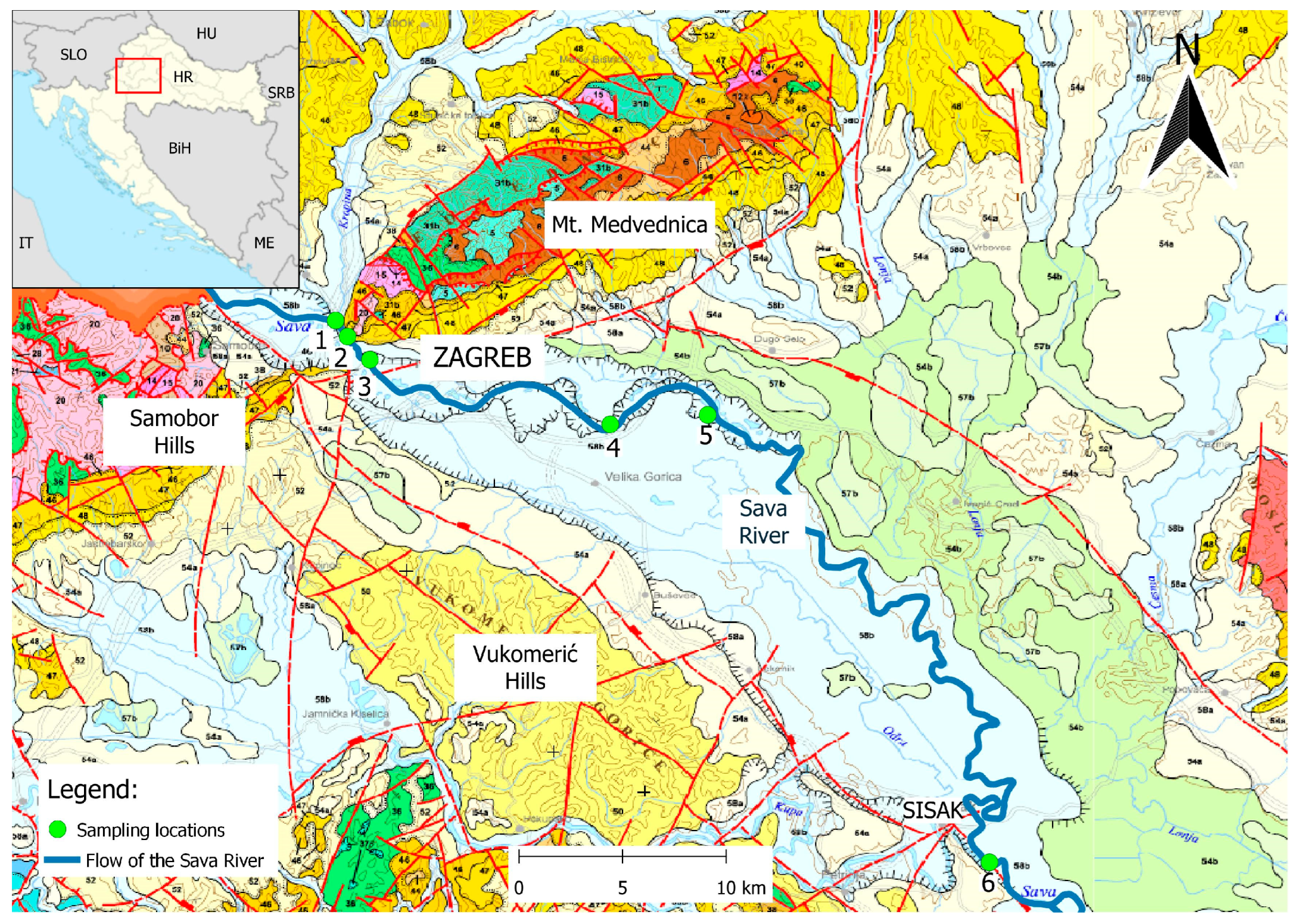

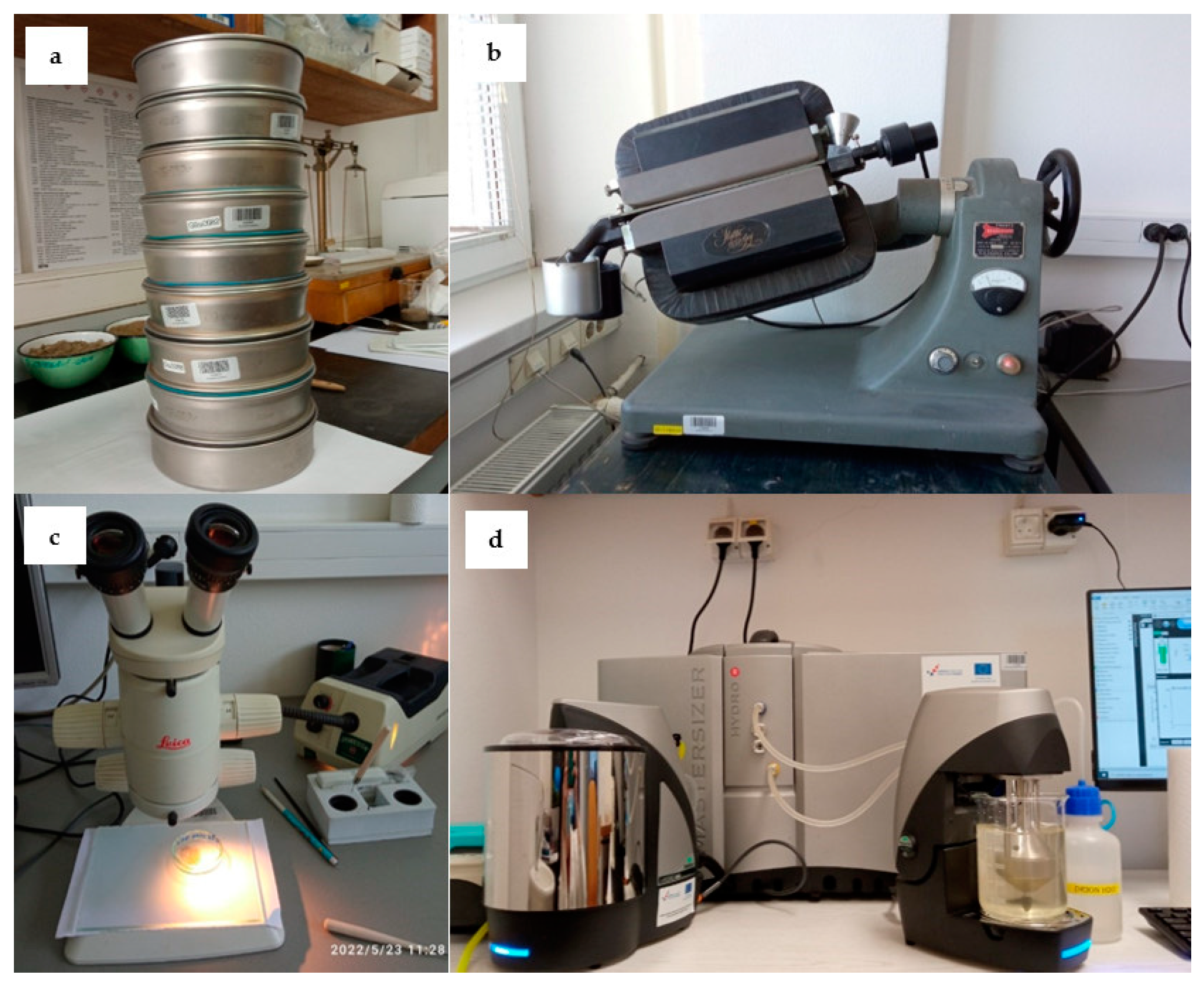

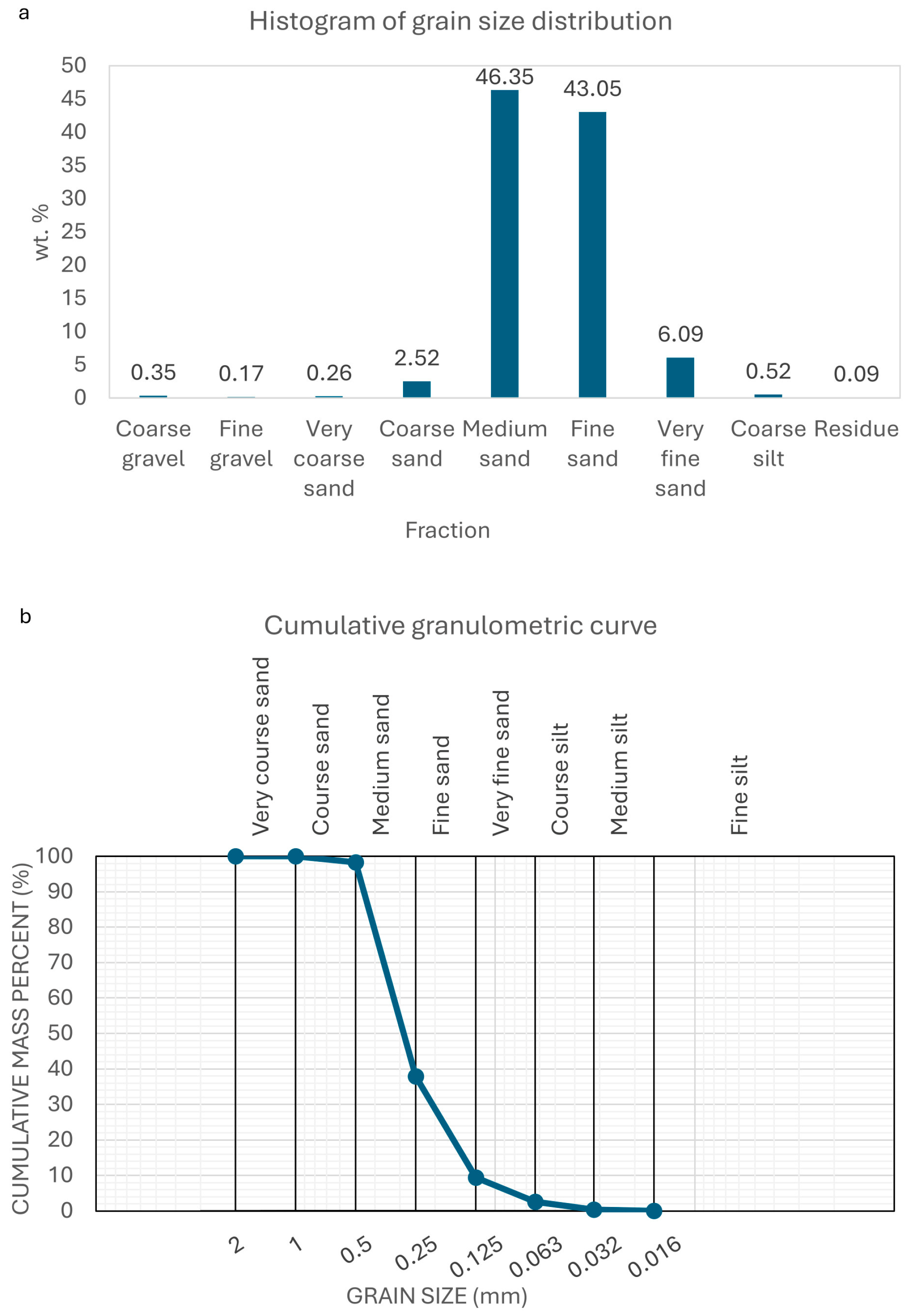


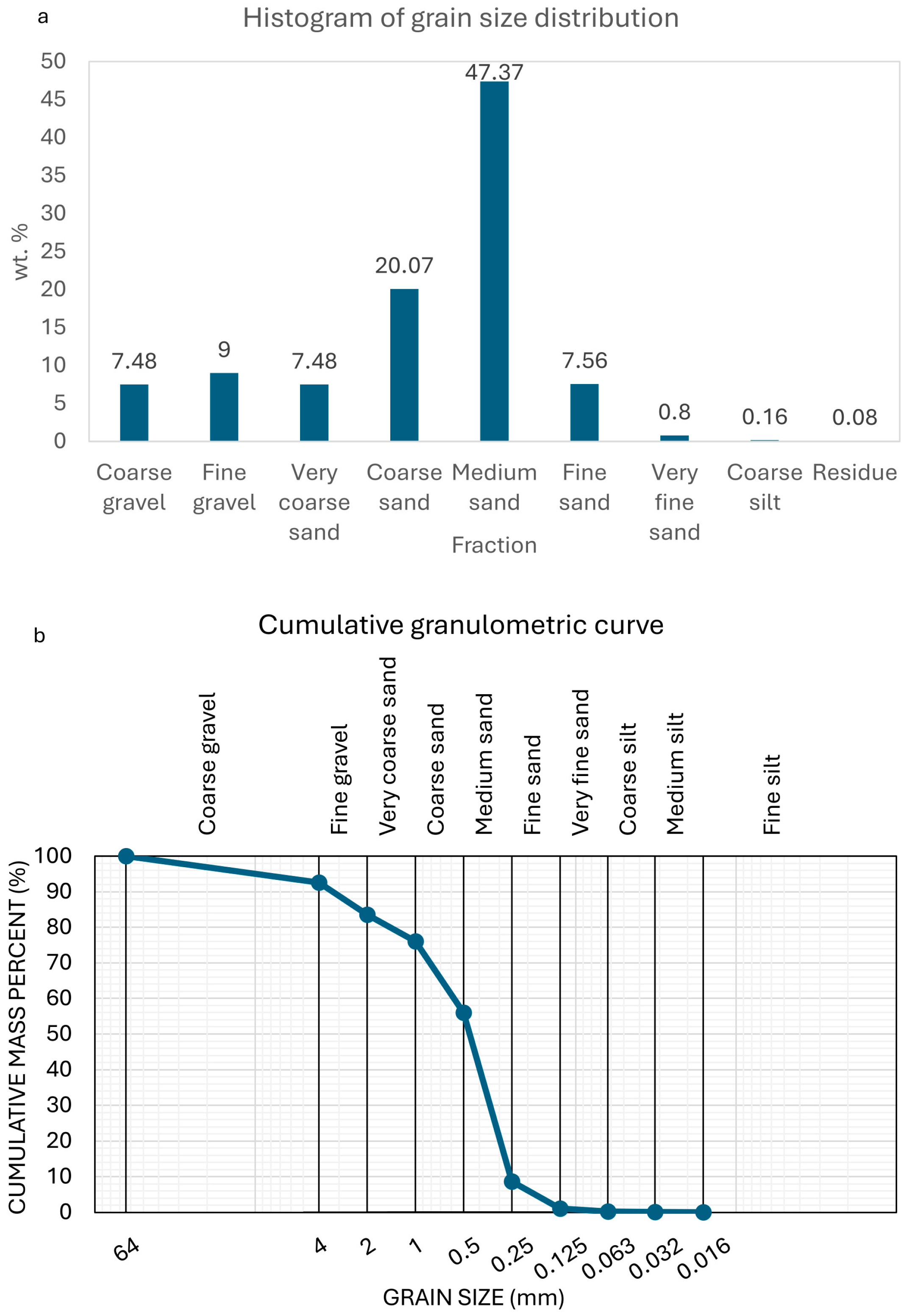
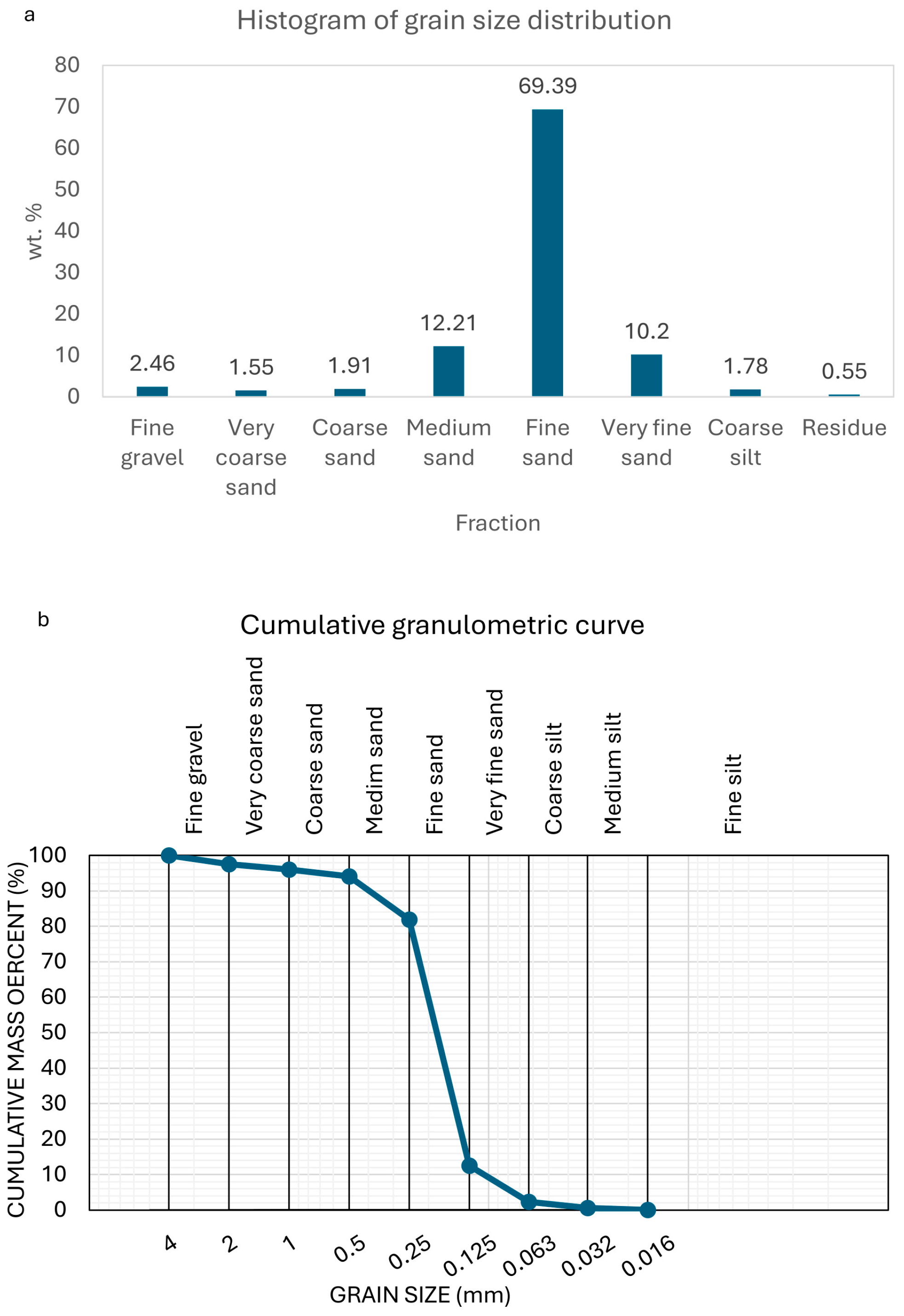

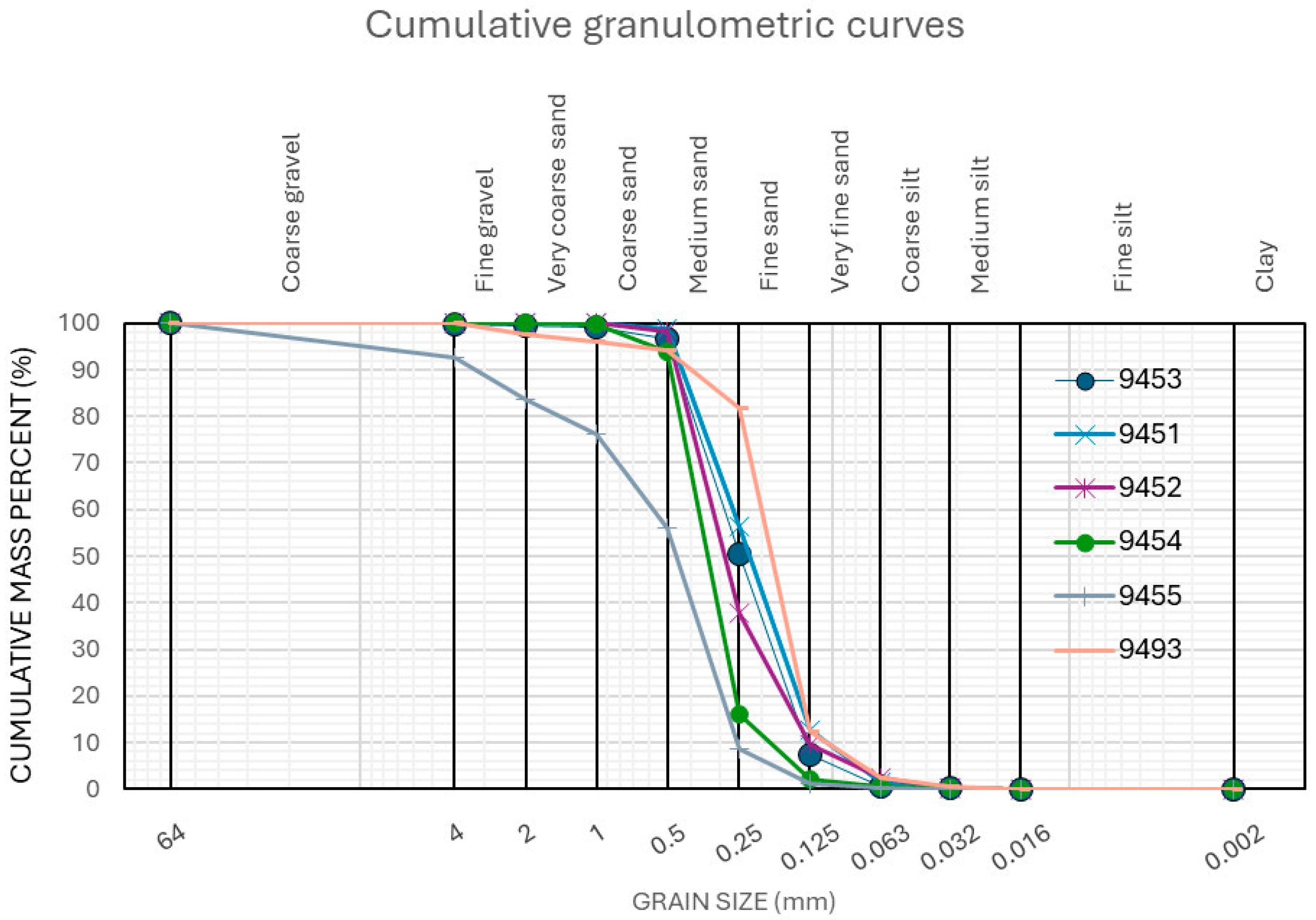
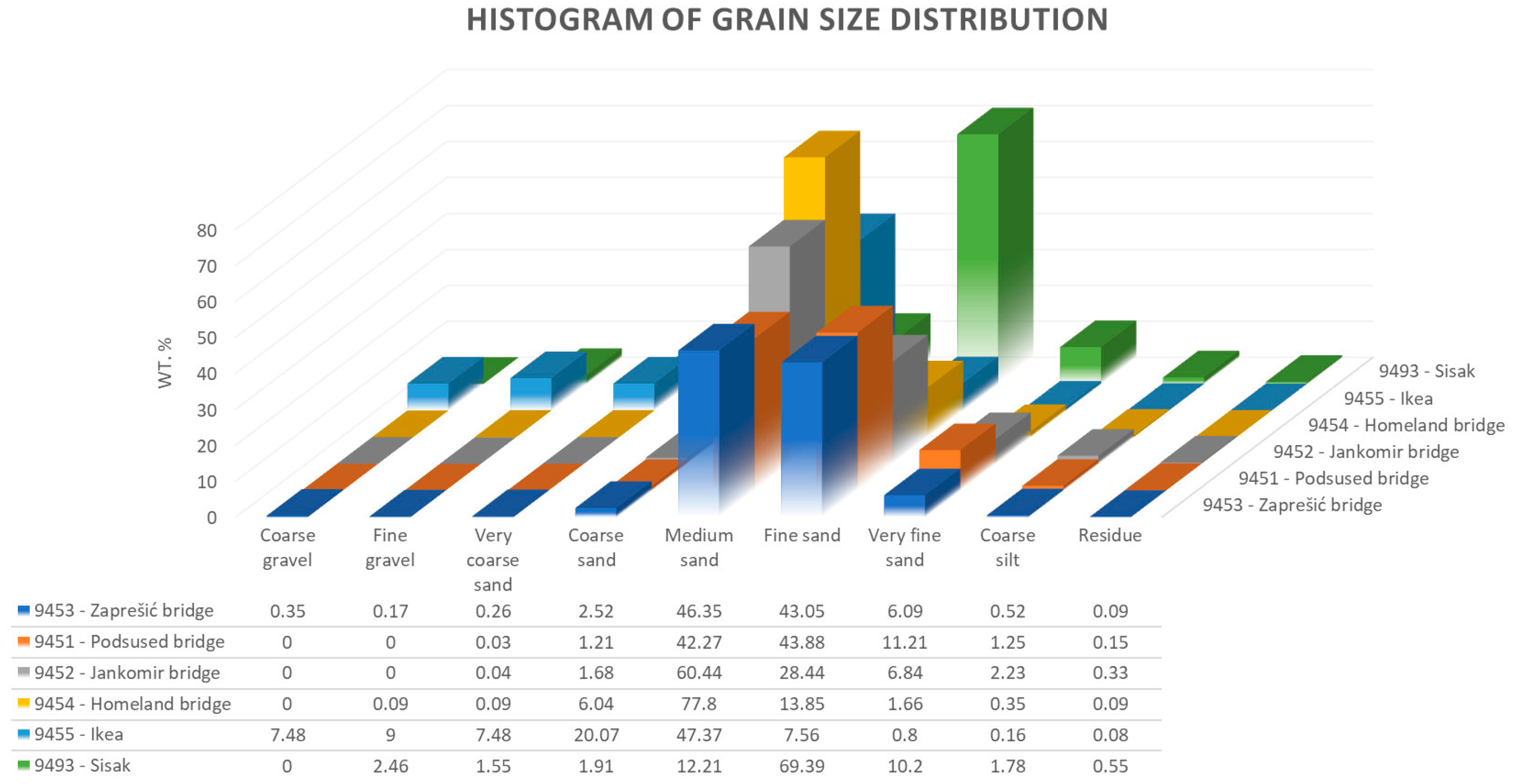
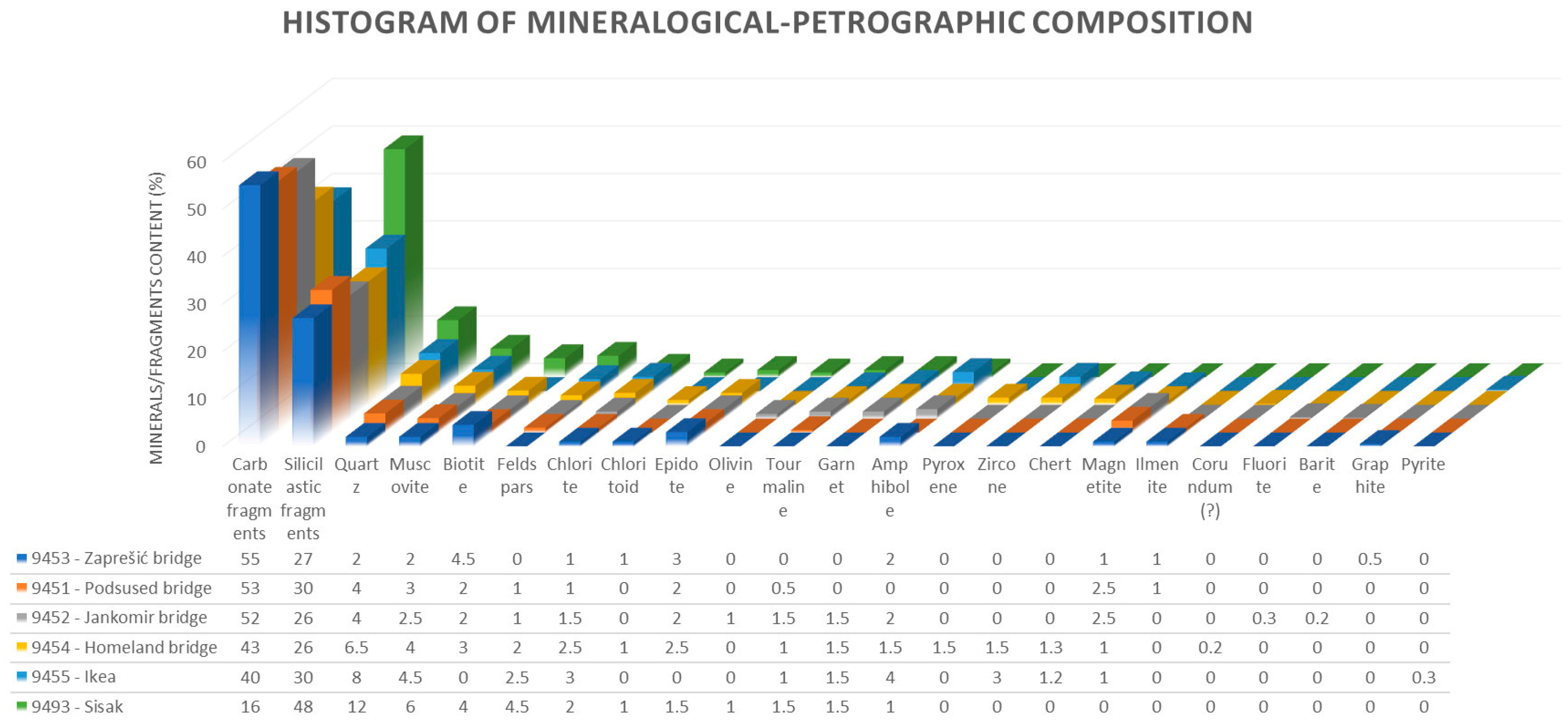
| Samples | Coordinates in HTRS96/TM | ||
|---|---|---|---|
| Field Mark | Lab Number | Easting | Northing |
| 1—Podsused Bridge | 9451 | 448,079.93 | 5,075,186.58 |
| 2—Jankomir Bridge | 9452 | 449,924.19 | 5,072,626.22 |
| 3—Zaprešić Bridge | 9453 | 447,162.77 | 5,076,738.34 |
| 4—Homeland Bridge | 9454 | 465,329.62 | 5,068,919.41 |
| 5—Ikea | 9455 | 471,386.61 | 5,071,575.00 |
| 6—Sisak | 9493 | 496,688.65 | 5,032,685.95 |
| Parameter | Samples-Sites | |||||
|---|---|---|---|---|---|---|
| 9453 | 9451 | 9752 | 9754 | 9455 | 9493 | |
| Φ5 | 0.1135 | 0.0878 | 0.0878 | 0.1436 | 0.215 | 0.094 |
| Φ16 | 0.14375 | 0.125 | 0.15 | 0.2 | 0.26 | 0.128 |
| Md | 0.25 | 0.225 | 0.2575 | 0.33 | 0.425 | 0.18125 |
| Φ84 | 0.417 | 0.41 | 0.417 | 0.417 | 2.0 | 0.265 |
| Φ95 | 0.46 | 0.45 | 0.455 | 0.455 | 4.5 | 0.615 |
| Mode | 0.5–0.25 | 0.25–0.125 | 0.5–0.25 | 0.5–0.25 | 0.5–0.25 | 0.25–0.125 |
| M | 0.27025 | 0.253 | 0.275 | 0.316 | 0.895 | 0.191 |
| So | 0.121 (<0.35) | 0.126 (<0.35) | 0.122 (<0.35) | 0.101 (<0.35) | 1.084 (<0.71; <2) | 0.113 (<0.35) |
| Sk | 0.217 (<1) | 0.270 (<1) | 0.135 (<1) | 0.198 (<1) | 0.856 (<1) | 0.44 (<1) |
Disclaimer/Publisher’s Note: The statements, opinions and data contained in all publications are solely those of the individual author(s) and contributor(s) and not of MDPI and/or the editor(s). MDPI and/or the editor(s) disclaim responsibility for any injury to people or property resulting from any ideas, methods, instructions or products referred to in the content. |
© 2024 by the authors. Licensee MDPI, Basel, Switzerland. This article is an open access article distributed under the terms and conditions of the Creative Commons Attribution (CC BY) license (https://creativecommons.org/licenses/by/4.0/).
Share and Cite
Barudžija, U.; Blatančić, M.; Malvić, T. Grain Size Distribution and Provenance of Holocene Sand from the Sava River (Zagreb, Croatia). Geosciences 2024, 14, 188. https://doi.org/10.3390/geosciences14070188
Barudžija U, Blatančić M, Malvić T. Grain Size Distribution and Provenance of Holocene Sand from the Sava River (Zagreb, Croatia). Geosciences. 2024; 14(7):188. https://doi.org/10.3390/geosciences14070188
Chicago/Turabian StyleBarudžija, Uroš, Matteo Blatančić, and Tomislav Malvić. 2024. "Grain Size Distribution and Provenance of Holocene Sand from the Sava River (Zagreb, Croatia)" Geosciences 14, no. 7: 188. https://doi.org/10.3390/geosciences14070188








